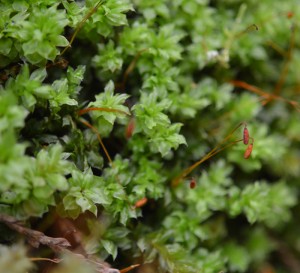As we found out, mosses are amazing creatures. They belong to a larger group called bryophytes which include mosses, liverworts, and hornworts.  These organisms all have a dominant gametophyte generation. So when you see a green moss you are looking at its gametophyte stage. This is the phase of the lifecycle that makes the gametes (eggs and sperm). The fertilized egg grows into another phase called the sporophyte which produces spores. The sporophyte looks a little like a lollipop with a round sporangium (contains spores) on top of a stalk (seta). A spore then grows into the gametophyte.
These organisms all have a dominant gametophyte generation. So when you see a green moss you are looking at its gametophyte stage. This is the phase of the lifecycle that makes the gametes (eggs and sperm). The fertilized egg grows into another phase called the sporophyte which produces spores. The sporophyte looks a little like a lollipop with a round sporangium (contains spores) on top of a stalk (seta). A spore then grows into the gametophyte.
This alternation of generations is shared by all plants. Vascular plants (flowering plants, conifers, and ferns) however, have a dominant sporophyte stage….i.e. trees are sporophytes. For example, the conifers we see around us are sporophytes and the gametophytes are reduced and tucked away into the cones. The male gametophytes are actually pollen!
Bryophytes have different life strategies to vascular plants. For example, most mosses are able to withstand being almost totally desiccated. Vascular plants have deep root systems that do all of the water absorbing for a plant….they have a waterproof outer covering that keeps the water inside except for the small pores (called stomata) that open and close to allow air in for photosynthesis. Bryophytes absorb their water and nutrients through their entire surface and when the surroundings are dry they can dehydrate and go into a kind of physiological hibernation. Their cells can tolerate desiccation while the cells of other types of plants would die if they were to dry out! Once mosses are rehydrated they recommence their cellular activities.
Bryophytes (and ferns too) require water for sexual reproduction. Sperm needs water to get to the egg! In most bryophytes the male parts and female parts are on separate plants so this makes sex risky business!
 Bryophytes are really good at asexual reproduction. That is they can reproduce without sex! Small fragments an grow into whole new plants. So….raking your lawn to get rid of moss may not work so well. Many of them also make tiny little propagules called gemma that reproduce clones of their parents too. The cup in the picture on the left is from Marchantia (a liverwort). It produces gemmae and is called a gemma cup.
Bryophytes are really good at asexual reproduction. That is they can reproduce without sex! Small fragments an grow into whole new plants. So….raking your lawn to get rid of moss may not work so well. Many of them also make tiny little propagules called gemma that reproduce clones of their parents too. The cup in the picture on the left is from Marchantia (a liverwort). It produces gemmae and is called a gemma cup.
